HomeReviewsFlintlock: The Siege Of Dawn
Flintlock: Siege Of Dawn review: a trim and sturdy Soulslite that’s best enjoyed in the airSome of the heft of God Of War and Souls, less of the pain and bulk
Some of the heft of God Of War and Souls, less of the pain and bulk
Image credit:Kepler Interactive / Rock Paper Shotgun
Image credit:Kepler Interactive / Rock Paper Shotgun
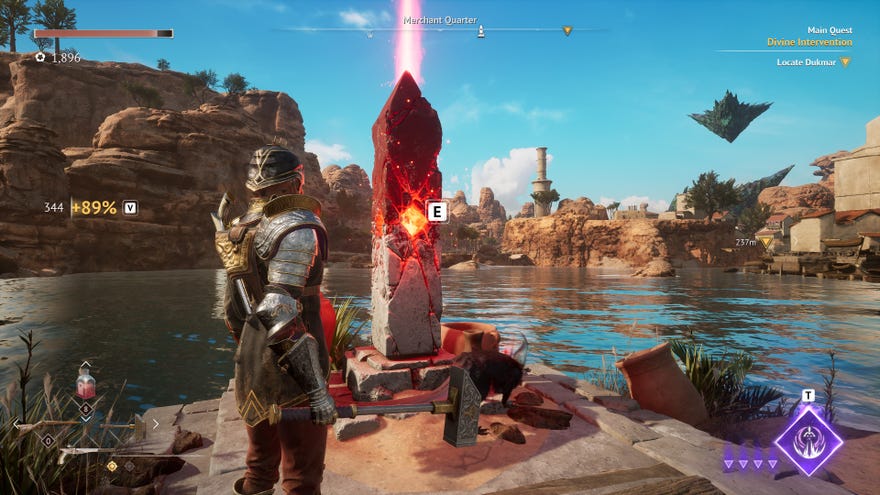
We’ll circle back to the shortcuts. First, some scene-setting. In Flintlock, you play Nor, a lean and rakish sapper from an army battling the legions of the dead. As the curtain goes up, Nor and her fellow field engineers accidentally breach a portal that lets loose a full-blown invasion of the underworld gods. The rest of the tale is about cramming the lid back on Pandora’s box, with Nor galloping between towns, fast travel wayshrines (which also respawn the local zombies) and bossfights with the escaped deities, while rallying her scattered friends to form a travelling caravan of sidequest-purveyors and upgrade-dispensers, who congregate at campfires in your wake.
Image credit:Kepler Interactive / Rock Paper Shotgun
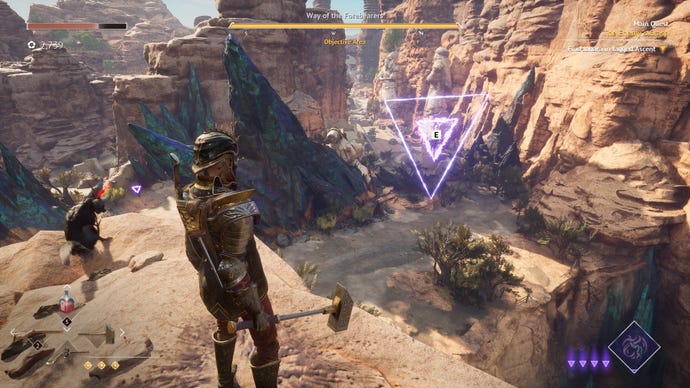
Early on Nor also befriends one of the stray gods, Enki, a feathery, foxlike spectre who accompanies you everywhere and is the source of your supernatural powers - in particular, Nor’s knack of punting herself around on gusts of enchanted blackpowder. Enki is God Of War’s Atreus, a support character mapped to a face button, but with some significant differences. Firstly, he’s not encumbered with any toxic filial angst, though he does have baggage concerning the nature of his godhood. Secondly, he has a smaller repertoire of support skills than Atreus - basically, you can hammer a button to make him curse opponents, “Priming” them for an armour-tearing canned attack or finisher, while amassing energy for a choice of AOE mega-spells.
This focus makes him more forgettable than Atreus, but also, less fussy. I feel the same way about much of Flintlock, which essentially splices God Of War with the Soulslike stylings of developer A44’s previousAshen, then boils the concoction down to a limber, 20-hour “Soulslite” with a handful of party tricks of its own devising. The result is a satisfying summer extravaganza that won’t eat up too many weekends, with a couple of dodgy fittings and the occasional flutter of genius.
The game’s inspirations are apparent from the title screen, but Flintlock wastes no time elaborating upon them. Nor wields a one-handed melee weapon in her right hand and a pistol in her left. As inBloodborne, the pistol is used primarily for defence - interrupting otherwise unblockable attacks, and prepping the enemy for a counter. But fresh pistols supply fresh uses. There’s a glowering radioactive treeroot whose projectiles detonate after a couple of seconds, slopping Prime over the target’s entourage. There’s a blunderbuss that merely tickles enemy healthbars, but also applies knockdown across a wide arc, making it the perfect antidote to a wandering horde.
Melee weapons, meanwhile, run a small, busy gamut from hammers that spill punishment through armour, to incendiary axes that sometimes let you wait out the fight. Each is a means of refilling your pistol, with the game awarding a gunpowder charge for every four swings that connect. As such, you’ll always be a multiclass, hacking at heads in order to earn the powder to counter the next unblockable hit, though the game’s progression system - whose upgrades can be reversed at will, recovering a portion of the associated XP, or “Reputation” - does allow you to torque your approach towards sorcery or butchery or gunslinging.
Image credit:Kepler Interactive / Rock Paper Shotgun
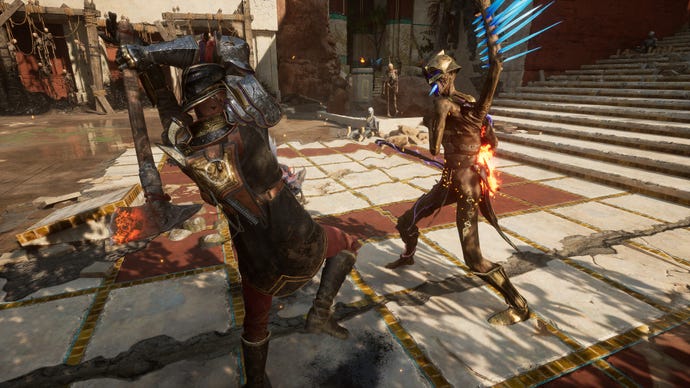
Atop this well-gauged combat chemistry, heap the effects of equipment and of ye olde equipment synergies. Right now, I’m wearing a set of togs that (if I remember correctly) cause me to explode whenever Enki applies four curses in a row, and also, whenever I earn powder, and also, whenever I attack out of a block. It’s making regular skirmishes a bit unscientific - sometimes, I can’t see myself for dust. It’s also a liability when roving dungeons stocked with gunpowder barrels and other volatile fixtures - Flintlock’s environment designers are perhaps a little too fond of these. I also have the option of a crystal-studded get-up that turns my dodge into a teleport, and a golden gauntlet that duplicates my grenades as they fly.
Pistols aside, Nor gets longer-ranged firearms in the shape of rifles, mortars and a gun that spits out rolling shells. In my hands, these tools exist for the sake of pruning snipers and cancelling the odd midboss I can’t be bothered to duel. Rather than organic extensions of the combat system, they feel like a safety valve for the inevitable tedium of any game that consists largely of melee. I don’t mind that they’re there, but they don’t feel necessary.
Image credit:Kepler Interactive / Rock Paper Shotgun
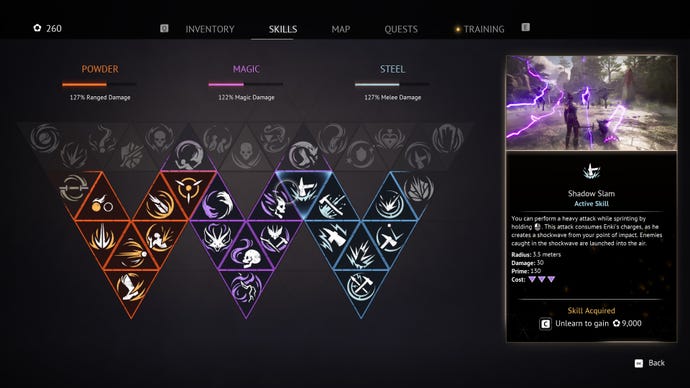
Some NPCs are players of Sebo, a gently appetising minigame which is sort of noughts-and-crosses played on a triangular board, using tokens that may have special abilities such as jumping over enemy pieces. It’s a nice addition, one I’d like to revisit now that I’m off deadline, but the artificial abundance of Sebo players reflects a setting that isn’t quite sure whether it’s a world or a procession of pace-changing distractions and glossy scenery.
Image credit:Kepler Interactive / Rock Paper Shotgun
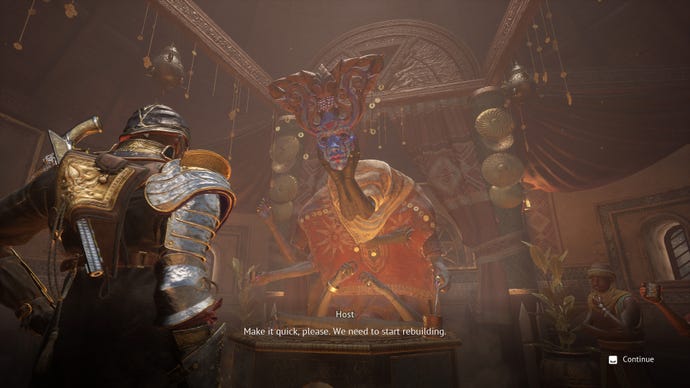
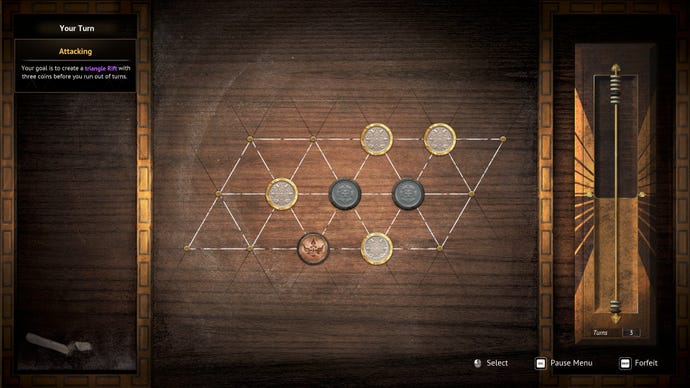
There’s always the danger of a practised genre hybrid shrinking to the sum of its influences, but Flintlock: Siege Of Dawn manages the feat of both pulling everything together and applying enough spin to stand apart. On which note, those shortcuts. Flipping and coursing between the cosmic triangles is a pleasure in itself, particularly when the game flirtatiously drags out the gap between certain grapple points, challenging you to air-dash and double-jump to continue the chain. But the real benefit is the sensation of unearthing a hidden designer’s logic, because teasing out those triangles is also the slow realisation that every layout, however dank and ghoul-clogged, however Souls-adjacent, is built to be savoured from above.
There’s a moment in the second major region when you find yourself at the summit of what is effectively a massive slide, a giddy slope among cliffs thickly lined with rotting crossbowmen. I whooped and slithered all the way to the campsite at the bottom, then located a skull plinth and set about cleansing the heights and discovering more plinths, till at last I could traverse the whole mountainside without getting my feet dirty. It provoked an emotion I hadn’t quite felt in Flintlock before: not just admiration of the sturdy craft on show, but delight.